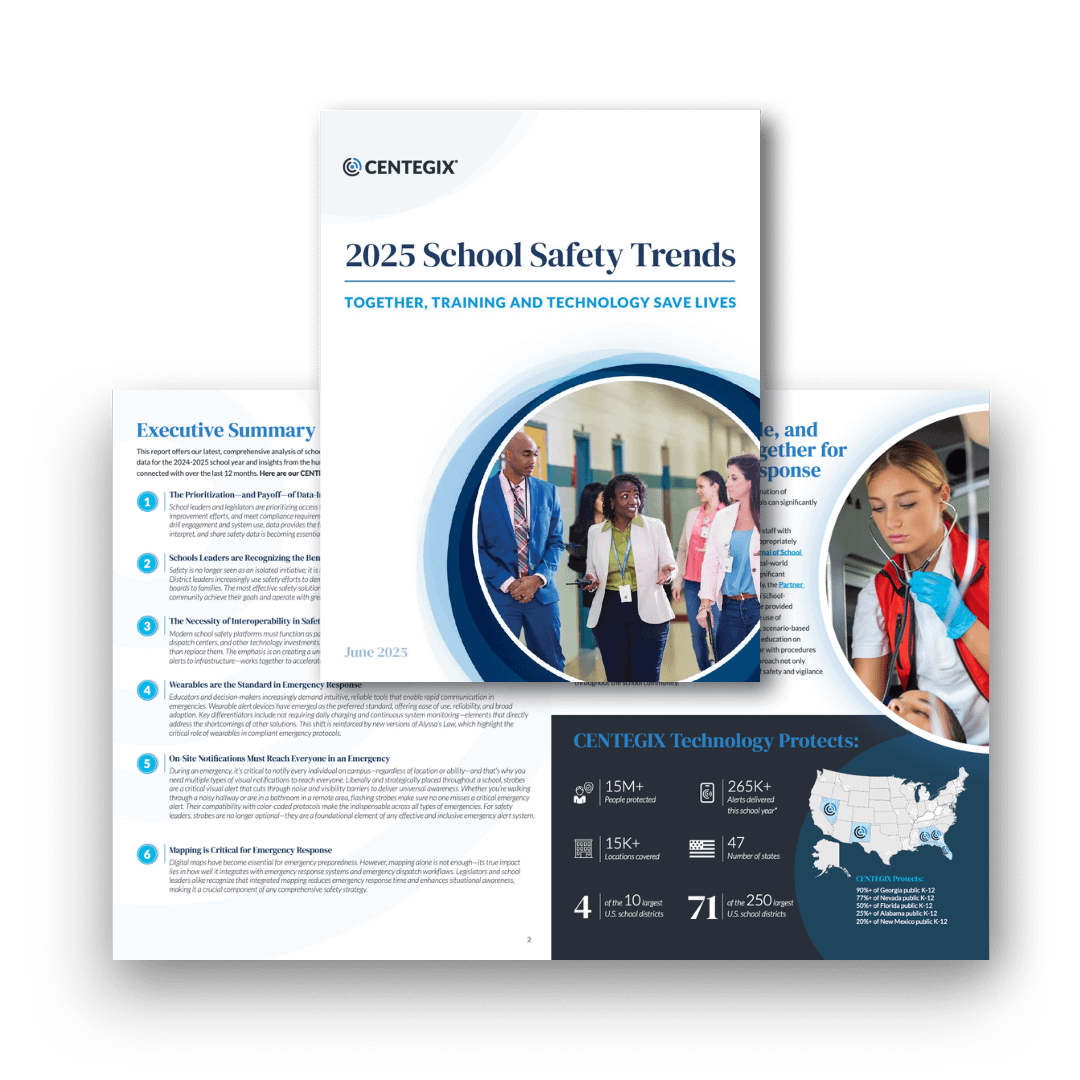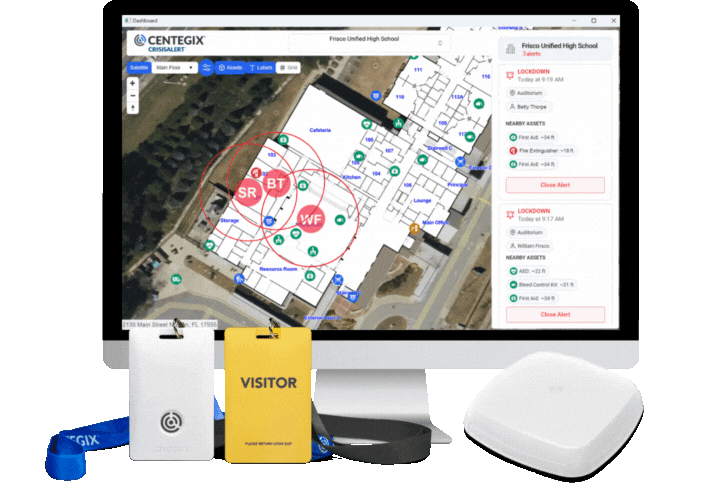CENTEGIX | Education
California School Safety Standards
CENTEGIX | Education
California School Safety Standards
California Assembly Bill 1747: School Safety Plans
California school alert systems are proactive acknowledgments that school violence has become a major concern and priority in safety planning in schools across the state. By California law, school districts need to develop Comprehensive School Safety Plans that should be adopted by March 1st each year to deal with a variety of emergencies:
- bomb threat
- bioterrorism/hazardous materials
- earthquake
- flood
- power failure/blackout
- intruders/solicitors
- weapons/assault/hostage
- explosion
- gas/fumes
- bomb threat
- bioterrorism/hazardous materials
- earthquake
- flood
- power failure/blackout
- intruders/solicitors
- weapons/assault/hostage
- explosion
- gas/fumes
Assembly Bill 1747 also requires California schools to include specific procedures “to prepare for active shooters or other armed assailants” in their schools safety plans. Training also should be available for staff and students, so they understand how to react in emergency situations.
In addition, plans should include clear guidelines for the roles and responsibilities of mental health professionals, school counselors, community intervention professionals, school resource officers, and police officers on campus.
Focusing on Prevention
The California Department of Education’s Project Cal-STOP provides free training to schools based on Sandy Hook Promise’s Know the Signs Programs:
- Start With Hello trains middle and high school students on how to recognize social isolation within their classroom and school. Students learn how to reach out and help.
- Say Something teaches middle and high school students to look for warning signs and threats—especially in social media—and to act immediately. Sandy Hook Promise also operates Say Something Tips, a website where students and staff can anonymously submit their safety concerns
- SAVE Promise Club is a student-led club that allows students to practice lessons from Start With Hello and Say Something. The club organizes activities on campus that promote a safe, respectful, and inclusive climate.
Cal-STOP also includes National Alliance on Mental Illness On Campus High School Club and Youth Mental Health First Aid training as ways to give troubled young people the help they need.
Additional Resources for Safety Planning
The California Department of Education has compiled resources about violence prevention, school safety planning, and more that California educational leaders can take advantage of when reviewing their district’s safety plans. Visit the CDE’s website to find targeted information on school safety issues, intervention prorgams, sample templates, guidance on training and implementation, and best practices.
The California Governor’s Office of Emergency Services has also created valuable resources for educators on school emergency preparedness planning and safety. Explore available resources on their website.
Funding for California School Safety Solutions
Federal Formula Grants
The list of federal formula grants awarded to California for the 2024-2025 state fiscal year includes:
- IDEA (fy 2023-24), $1,328,829,000
- Title I-A, $2,048,279,425
- Title II-A, $219,471,000
- Title IV-A, $145,227,534
Enhancing School Capacity to Address Youth Violence
The Office of Justice and Juvenile Delinquency Prevention (OJJDP) will fund targeted, evidence-based prevention and intervention programs to address youth violence in schools. The program’s goals are to reduce the incidence of school violence through improved school safety and climate and to prevent youth violence, delinquency, and victimization in the targeted community. Schools implementing school safety solutions should show how these solutions prevent violence and improve the climate of safety in schools. Learn more about the program here.
Community Based Violence Intervention and Prevention Initiative
The Office of Justice Programs created the Community Based Violence Intervention and Prevention Initiative to “prevent and reduce violent crime in communities by supporting comprehensive, evidence-based community-based violence intervention and prevention programs.” Learn more about the program here.
COPS School Violence Prevention Program
The U.S. Department of Justice oversees the COPS School Violence Prevention Program, which distributes funding for evidence-based school safety programs and technologies. School safety solutions that help identify potential dangers are eligible for COPS funding. Districts can also use funds to improve emergency notification and response systems, including California school alert systems. To learn more, visit the COPS website.
BJA'S Stop School Violence Program
The U.S. Department of Justice has also made funds available through the Bureau of Justice Assistance. BJA’s STOP School Violence Program funds the purchase of school safety software designed to help K-12 schools maintain a safe environment. This program’s priorities are recognizing, responding to, and preventing violence on campus. BJA will allocate $82 million to STOP School Violence Program competitive grants in fiscal year 2024.
CENTEGIX Safety Report
2025 School Safety Trends: Together, Training and Technology Save Lives
Discover our latest, comprehensive analysis of school safety incidents gathered from the CENTEGIX Safety Platform™ usage data for the 2024-2025 school year, as well as insights from the hundreds of school safety and district administration leaders we’ve connected with over the last 12 months, in our report 2025 School Safety Trends: Together, Training and Technology Save Lives.
Download your copy today.

How Are Your Resources Being Spent?
CENTEGIX protects over 15,000 locations across the country. We can protect yours, too.
The CENTEGIX Safety Platform™, featuring CrisisAlert™, accelerates your response to emergencies. We’ve built the CENTEGIX Safety Platform to support you in the single most critical factor of incident response: time.
Discover federal resources to fund new safety and security initiatives in your district by exploring federal funding resources for school safety.

Championing Safe Schools with California Educators









Hear from Our California Educators
We engage with teachers and staff every day to understand how CrisisAlert and the CENTEGIX Safety Platform support them, and here’s what they’ve shared:
I have mentioned to my family and a number of staff members how much safer I feel having this badge while at work.
There was an incident where a student was injured lifting weights and needed help. [CrisiAlert] worked so fast and exactly how they trained us.
A fight broke out on the quad and was escalating quickly with other students. For teachers, [CrisisAlert] is a quick lifeline to help.
Discover the Safety Platform
Safety solutions that prioritize speed for the best outcome.
Mapping and locating capabilities provide the precise location—of emergencies, visitors, and safety assets.
A visitor management system screens and locates visitors on your campus.
Protocol development to plan for rapid incident response.


Partner of AEPA and CalSave
CalSave uses national leverage to seek best pricing on its purchasing contracts. As a participating member of the Association of Educational Purchasing Agencies (AEPA), a multi-state non-profit organization made up of Educational Service Agencies / political subdivisions organized through a Memorandum of Understanding between all participating states, CalSave works with educational purchasing cooperatives in 26 other states. In California, awards are made by MCOE based on the application of California law.
CENTEGIX is a proud AEPA-awarded member in the state of California through CalSave as a Security Solution. We look forward to the opportunity to explore and solve your school safety needs. Learn more here.
CrisisAlert Is in a Class of Its Own
We don’t just raise the bar. We built it.
CrisisAlert leads the industry in wearable panic button technology. As the most trusted, proven, and deployed solution on the market, it delivers unrivaled reliability, redundancy, notification, and response capabilities.
Unlike other wearable panic buttons, CrisisAlert activates a fully integrated emergency response and notification system, including flashing strobes, intercom announcements, and computer screen takeovers. It’s the only solution with 100% campus-wide coverage that immediately sends a digital map to first responders with precise location details, down to the exact floor and room, detailing every safety asset in proximity of the alert, to protect your staff wherever they are.
In an Emergency, You Need CrisisAlert™
Adverse situations can happen at any moment—from everyday crises such as medical emergencies, severe weather, and physical altercations to extreme situations that threaten your entire campus. The faster you get help to the right location, the better the outcome.
See how our CrisisAlert wearable mobile panic button empowers staff to get help instantly in an emergency.
Ready to Protect Your School District with CENTEGIX?
"*" indicates required fields
*By providing my phone number to CENTEGIX, I agree and acknowledge that CENTEGIX may send text messages to my wireless phone number for any purpose. Message and data rates may apply. CENTEGIX will only send one SMS as a reply, and I will be able to Opt-out by replying “STOP”. **No mobile information will be shared with third parties/affiliates for marketing/promotional purposes.*

Empower Your Educators
with Safety
Explore More Safety Resources
Supporting the Unique Safety Needs of Special Education Students and Staff
In our case study, learn how Meade County School District has supported and empowered their special education staff and students with the CENTEGIX Safety Platform™.
Visitor Management: Best Practices for Your School Safety Plan
CENTEGIX empowers thousands of schools to take control of their visitor management and protect their teachers, students, and staff. Get a copy of our Visitor Management Best Practices Guide today.
2024 School Safety Trends Report
This report offers our latest, comprehensive analysis of school safety incidents gathered from the CENTEGIX Safety Platform™ usage data for the 2023-2024 school year.
School Safety Standards by State
Schools in any state can meet school safety grant funding requirements by choosing the CENTEGIX Safety Platform™. Learn more about school safety in your state.

How to Comply with Alyssa’s Law in Washington
CENTEGIX CrisisAlert wearable panic buttons enable Washington schools to achieve compliance with Alyssa’s Law, SB 5004.

Board Chair POV: CENTEGIX is the Best Choice for Student Safety
Former DeKalb County Board Chair endorses the CENTEGIX Safety Platform as the best choice for creating safe schools.

CENTEGIX Launches Completely Reimagined Visitor Management Solution
CENTEGIX®, the industry leader in wearable safety technology, recently unveiled its reimagined Visitor Management Solution during a webinar on June 18. Built from the ground up, this new solution delivers faster and more flexible tools to streamline visitor check-ins, enhance security, and simplify operations for schools and facilities.

How to Prepare for Alyssa’s Law in Oklahoma: HB 4073
Oklahoma districts create safe schools and meet HB 4073 requirements by implementing the CENTEGIX Safety Platform.
SOLUTIONS
INDUSTRIES
RESOURCES
COMPANY
PARTNERS
CONTACT
EVERY. SECOND. MATTERS.®





